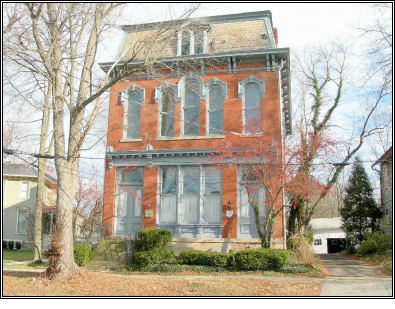
Today this imposing 3-story red brick building seems out of place on the south side of Poland Village. It is surrounded by old residential homes and modern condominiums, causing an observer to question why this large structure was placed in this location. But one must remember that this area was once a thriving commercial district with many stores and shops. Back 135 years ago 409 South Main Street was located at the intersection of two well traveled highways. Farmers passed here on their way to the Fowler Grist Mill on Yellow Creek to have their wheat ground into flour. They would return home in their wagons or buggies after shopping at Poland’s merchants. Poland was the center of a wide farming community and it furnished all the necessities of the farmer, including blacksmith and leather shops selling harnesses and hardware. What better location to build a bank to be called The Farmers Deposit and Savings Bank?
In 1874, Robert Long Walker was a very rich man, having acquired his wealth during the Civil War in the coal mining industry. Now with the industrial revolution rolling into high gear Walker and several other successful Poland professional men needed the services of a bank to do their every day transactions. Since no banking institutions were close at hand, it seemed logical to Mr. Walker, Turhand Kirtland Hall, Samuel Hine, Dr. Eli Mygatt and Clark Stough to start their own bank. They filed for incorporation on October 16, 1874 and began building a bank, which architecturally, would represent strength and dependability to its depositors. Their bank flourished for a short period of time, but as farming began to decline the local citizens began moving their finances to the larger banking institutions in Youngstown. Poland’s bank closed in 1923 and the building was converted into two low rent apartments. Over the period of the next 45 years the building gradually deteriorated. In 1969 John Weed Powers purchased the building and renovated the bank with new wiring, new roof, and new apartments in the basement and attic.
As you stand facing the front of the old bank building you immediately notice two entrance doors. The door on the left once opened into the bank lobby where a large concrete vault was located. The front steps on the right have been removed but this door once provided access to a large meeting room on the second floor where many social activities occurred, including lectures, concerts and dancing. The interior stairway leading to the second floor has been removed to enlarge the first floor apartment while the bank’s vault has been converted into a modern bathroom with two-foot thick walls. In the rear of the old bank are parking garages for the residents and a doorway leading to stairs for the four modern apartments. If Mr. R.L.Walker was alive today, he would undoubtedly be pleased with the way his bank building has been preserved and how it is once again an asset to the historical community of Poland.
